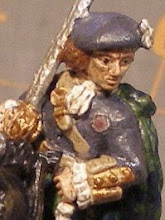Finally I've completed all of the units for the 4th Prussian Brigade, III Korps (August 1813) commanded by Generalleutnant von Bulow. This "brigade" is actually a division sized unit as were all of the Prussian "brigades." They did this to get around part of the onerous French terms after the 1807 capitulation of Prussia.
The 4th Brigade was commanded by Generalmajor von Thumen and was composed of:
Infantry Regiment # 5, 4th East Prussian (of three battalions and a volunteer jager detachment)
5th Reserve Infantry Regiment (of three battalions and a volunteer jager detachment)
half battalion, East Prussian Jager Battalion, #2
Elbe Infantry Regiment (of two battalions and a volunteer jager detachment) [Should have three and will if I ever run across the requisite number of Hinchliffe figures.]
Pomeranian Light National Cavalry Regiment
Foot Artillery Company # 6 (equipped with four 6-lb cannon and two 7-lb howitzers) [Should have six cannon and will if I can get the requisite gunners and cannon.]
As you can see this is a formidable fighting force although light on artillery and cavalry, additional assets of which were provided by the corps.
 |
| Pomeranian Light National Cavalry Regiment, composed of eight vintage 25mm Der Kriegspieler one-piece cavalry figures. |
 |
| Slightly different view of the four 2-figure stands that compose the regiment. |
The Pomeranian Light Cavalry Regiment was one of four national cavalry regiments formed in 1813 by the resurgent Prussian Army. It was dressed in an uhlan style uniform with a dark green kollet and grey overalls. The regiment was armed as a light cavalry regiment with sabers and carbines. In 1815, this formation was divided between the Guard Dragoon and 4th Uhlan Regiments. [Information courtesy of David Nash's
The Prussian Army: 1808-1815 (Almark Publications, 1972), my "bible for the Prussian Army.]
In addition to the 4th Brigade, my III Korps Prussian forces include the complete 3rd Brigade (three 3-battalion infantry regiments, one grenadier battalion, one hussar regiment, and one foot artillery company, plus four volunteer jager detachments), the still forming 5th Brigade (one 3-battalion infantry regiment and one hussar regiment) and 6th Brigade (one Landwehr cavalry regiment), almost all of the corps cavalry (three dragoon regiments, one hussar regiment, one uhlan regiment, and one Landwehr [of three] cavalry regiment), and most of the corps artillery (two 12-lb foot companies and one 6-lb horse company). The Prussian III Korps was part of the Alllied Army of the North, commanded by Crown Prince Bernadotte of Sweden (a former Napoleonic French marshal).
Plus I have scattered units from the I Korps, commanded by Generalleutnant von Yorck (five grenadier battalions and five cavalry regiments), which was assigned to the Army of Silesia, commanded by General der Kavallerie von Blucher.
























